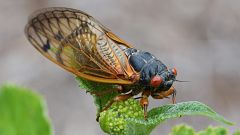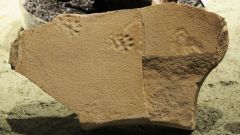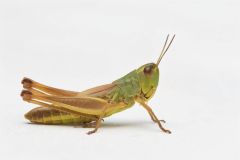Biology

Apr 25th, 2025 - It's cicada season again. Any time now, these flying insects will emerge from the ground and make an absolute ruckus as they look for mates before disappearing again. The noise from cicadas can be as loud as a motorcycle or a chainsaw in some cases. Investing in a good pair of noise-cancelling headphones is one way to get ready for the insect invasion. I still remember the first year I saw a major cicada brood emerge. As a teenager, I watched as the swarm descended on my ... [Read More]
Source: cnet.com

Apr 25th, 2025 - Pups of the greater sac-winged bat have been recorded spending a significant part of their day making a curious chatter. This chatter, known as babbling, lasts around seven minutes on average, with some sessions reaching an impressive 43 minutes. Researchers studied 19 pup-mother pairs in roosts across Panama and Costa Rica. According to Dr. Ahana A. Fernandez from the Smithsonian Tropical Research Institute , the project focused on how maternal behavior influences this vocal practice in young ... [Read More]
Source: earth.com

Apr 25th, 2025 - Sign up for CNN's Wonder Theory science newsletter. Explore the universe with news on fascinating discoveries, scientific advancements and more . About 50 million years ago, a small bird waded along a lakeshore in what today is central Oregon. A worm wriggled at its feet. The bird appeared to probe the silty earth with its beak, once, twice, three times, looking for food. On the fourth try, the bird may have found something. Or perhaps it missed again and moved on. This glimpse into prehistory ... [Read More]
Source: cnn.com

Apr 25th, 2025 - Male blue-lined octopuses paralyze their mates to survive the perils of reproduction. It's not uncommon for sex in nature to include a bit of violence. But in the shadowy tide pools and coral reefs of the Pacific, an extraordinary mating duel is unfolding. The blue-lined octopus ( Hapalochlaena fasciata ), a tiny but deadly cephalopod, has developed a unique and ruthless solution to a longstanding problem: surviving mating. A Deadly Embrace Sexual cannibalism is common in cephalopods. Female ... [Read More]
Source: zmescience.com

Apr 25th, 2025 - Small, hungry crabs may be unsung heroes in the fight to save the Great Barrier Reef, playing a critical role in controlling populations of the destructive crown-of-thorns starfish. New research published in Proceedings of the National Academy of Sciences of the United States of America reveals compelling evidence of crab predation on juvenile crown-of-thorns, offering fresh insights into natural solutions for reef conservation. The research suggests that small crabs could play a big role in ... [Read More]
Source: cosmosmagazine.com

Apr 25th, 2025 - In a groundbreaking discovery, scientists in Brazil have discovered the world's oldest known ant fossil of a 113-million-year-old specimen of a fearsome predator known as a "hell ant." Unearthed from limestone in northeastern Brazil, this fossil dramatically reshapes our understanding of ant evolution, pushing back their known history by over 13 million years. Published in Current Biology, the study reveals that ants were already diverse and widespread during the time of dinosaurs. With ... [Read More]
Source: timesofindia.indiatimes.com

Apr 25th, 2025 - Long before humans roamed the Australian continent, the land teemed with giants. Towering reptiles, thunderous birds, and hulking marsupials defined a wild and ancient world of sprawling rainforest ecosystems. Among these formidable creatures was Protemnodon , a now-extinct genus of giant kangaroo. Despite its size – some individuals tipped the scales at 170 kilograms (375 pounds) – it wasn't a long-range wanderer. Instead, Protemnodon lived a curiously local life. New ... [Read More]
Source: earth.com

Apr 25th, 2025 - By Richard Musgrove An invasion by ugly but tasty sea creatures might save Tasmania's kelp forests. But first there has to be some over-fishing. Tasting salty and fishy, and looking like orange-yellow mandarin slices, sea urchin roe is a delicacy, driving a billion dollar global market, with 80% consumed in Japan. Rising sea temperatures are forcing many marine species south, including the long-spined sea urchins. Sea urchins can reach 10cm or more across and are deep-red to midnight black with ... [Read More]
Source: cosmosmagazine.com

Apr 25th, 2025 - The creation of three "dire wolf" pups has raised hopes that it may be possible to resurrect extinct animals. But some scientists have grave concerns. When news broke that Colossal Biosciences, a Dallas-based biotechnology company, had resurrected three extinct dire wolves , the internet reacted with awe. It is a species that last roamed the earth some 13,000 years ago, but has found recent fame thanks to Game of Thrones, which features fictional dire wolves. The story was stoked further when a ... [Read More]
Source: bbc.com

Apr 25th, 2025 - If an experiment is repeated under similar conditions, the results should be the same. In reality, the situation is often different—scientists speak of a "reproducibility crisis," which affects different disciplines. A recent study by an 11-member research team from the Universities of Münster, Bielefeld and Jena has provided evidence that some results of behavioral experiments with insects cannot be fully reproduced. Nevertheless, at least half of the findings in the various ... [Read More]
Source: phys.org

Apr 24th, 2025 - A giant "sea dragon" backbone plucked from a riverbank in Mississippi could belong to the largest mosasaur ever found in the state, scientists say. Researchers only found a single vertebra from the creature and aren't sure exactly how large the mosasaur was in total, but it is estimated to have been at least 30 feet (9 meters) long, Hattiesburg American reported. Mosasaurs, or "sea dragons," ruled the oceans when dinosaurs dominated the land towards the end of the Cretaceous period (145 million ... [Read More]
Source: livescience.com

Apr 23rd, 2025 - Sign up for CNN's Wonder Theory science newsletter. Explore the universe with news on fascinating discoveries, scientific advancements and more . (CNN) — A massive, extinct reptile that once snacked on dinosaurs had a broad snout like an alligator's, but it owed its success to a trait that modern alligators lack: tolerance for salt water. Deinosuchus was one of the largest crocodilians that ever lived, with a body nearly as long as a bus and teeth the size of bananas. From about 82 ... [Read More]
Source: cnn.com

Apr 23rd, 2025 - Step outside on a warm summer evening, and you'll likely notice something missing – fewer buzzing bees, fluttering butterflies, or humming beetles. Across the globe, insect numbers are crashing. These small creatures may not grab headlines like tigers or elephants, but they play vital roles in pollination, decomposition, and supporting ecosystems. Without them, life on Earth would unravel in quiet but devastating ways. The concern isn't new, but recent efforts to grasp the scale and ... [Read More]
Source: earth.com

Apr 23rd, 2025 - Looking again through the magnifying lens at the fossil's surface, one of us, Sabrina Curran , took a deep breath. Illuminated by a strong light positioned nearly parallel to the surface of the bone, the V-shaped lines were clearly there on the fossil . There was no mistaking what they meant. She'd seen them before, on bones that were butchered with stone tools about 1.8 million years ago , from a site called Dmanisi in Georgia. These were cut marks made by a human ancestor wielding a stone ... [Read More]
Source: livescience.com

Apr 22nd, 2025 - Some people will tell you that the dire wolves are back, while others will tell you they are not. Colossal Biosciences kicked off an avalanche of media coverage, including both hype and harsh criticism, when the company said it brought back dire wolves, an extinct species given renewed popularity by its role in the Game of Thrones franchise, using gene-editing and cloning technology. We will discuss the details of what Colossal has accomplished, but this technology also raises a bigger question ... [Read More]
Source: cnet.com

Apr 22nd, 2025 - Fifteen years ago, a cold snap froze much of Florida's wildlife to death — including many of the state's invasive Burmese pythons ( Python bivittatus ). But in this excerpt from " Slither: How Nature's Most Maligned Creatures Illuminate Our World " (Gand Central Publishing, 2025), science writer Stephen Hall reveals that a subset of these pythons were genetically predisposed to survive the cold, setting the stage for rapid evolution that could help the invasive snakes spread further into ... [Read More]
Source: livescience.com